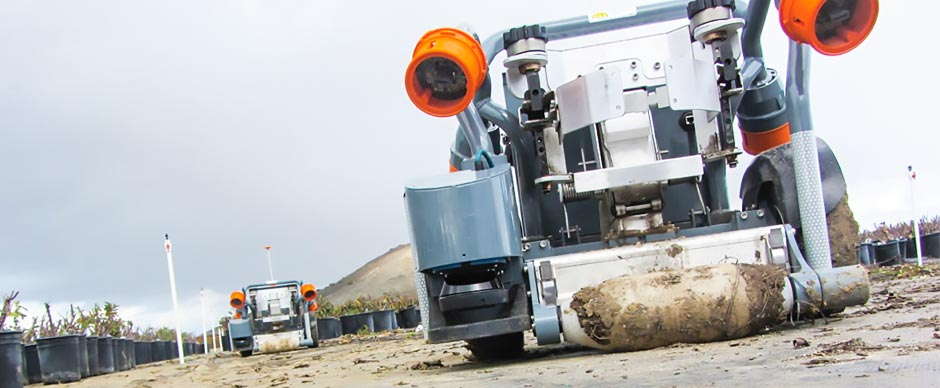Robots Grab Hold Of Growers’ Material Handling Needs
 In a day and age in which time is money, efficiency is top of mind for most growers. So when it’s possible to automate a task and reassign those employees to other, more productive and valuable tasks, the payoff can be high.
In a day and age in which time is money, efficiency is top of mind for most growers. So when it’s possible to automate a task and reassign those employees to other, more productive and valuable tasks, the payoff can be high.
However, the trick with precision horticulture is for growers to look at the initial investment, sometimes perceived to be out of range, and consider the savings, not only from saving labor and reassigning it in other areas, but also from the increased precision and efficacy that automation often provides. Additionally, reducing injuries and worker compensation, retaining employees who may have otherwise quit to find an easier job and just generally improving employee morale, are all benefits of investing in automation technology.
Harvest Automation’s HV-100 robots provides one avenue for labor savings in a repetitive, time-consuming, back-crushing job — plant spacing. These mobile, autonomous robots, tested in a variety of grower operations across the country, allow growers to automate a job that is the least desirable among employees.
Its experience working with growers to develop and tweak the HV-100 robots has launched Harvest Automation into more areas of promising robot technology, which will help growers in the greenhouse industry, as well as other areas of agriculture.
Robot Fleets For Sale Or Rent
During the summer and fall of 2012, Harvest Automation worked closely with customers to beta-test robots, and began offering the HV-100 for sale commercially in 2013. Today, Harvest Automation’s Product Management Director Matthew Aprea says there is a solid backlog of orders for new robots.
“By the beginning of the big, spring growing season, we’ll have approximately 30 customers and nearly 200 robots productively operating in the field,” he says.
That includes its robust introductory Robot Rental Program, which encompasses about 30 percent of the current fleet. The program, started in late 2014, offers growers a way to try out the robots, and has received a positive response thus far, Aprea says.
“We started the program — four robots, three months, $15,000 — as a way to ease customers into renting robots with a low-risk, high-value program that’s designed to rapidly produce results,” he says. “We immediately saw a positive response that exceeded our expectations and have thus decided to extend the program into spring.”
There are distinct advantages to both leasing and owning robots, Aprea says. In many cases, growers who have been pleased with the robots’ performance have opted to buy their fleet.
“For those taking their first look at robots, the program represents a low-risk way to evaluate the productivity gains that they’ll see with robots,” he says. “It also allows their workforce to become comfortable with operating robots. Customers quickly see that the benefits to using robots go well beyond the dollars and cents bottom line, and that the intangibles of lower employee turnover, improved worker health and safety and workforce sustainability represent real value. In the end, most customers choose to buy and eventually to expand their use of robots, to lock in these benefits for the long term.”
Reducing Labor Pain Points With Automation
Most of the growers who have used the HV-100 robots are realizing that they are using the labor forces they have more productively as a result, Aprea says.
“Tasks that previously were not completed, such as on-time spacing, weeding and pruning, are able to be accomplished on time, and as a result, customers are producing a higher quality product with the same workforce.”
This is certainly the case for Altman Plants, headquartered in Vista, Calif., says General Manager Jim Hessler.
“Nobody lost their job to the robots, but we were able to take one of the most undesirable tasks in the nursery (spacing), give that job to the robots and use our people for other jobs that require a human touch.”
At Metrolina Greenhouses in Huntersville, N.C., Labor Director Jay Kobylarz says while less labor was used to space the crops, not all robot use was for spacing. Metrolina also used the robots to set down production on 15 acres of outdoor space, as well.
Employees’ initial reactions to the robot testing phase in fall 2013 were negative, as they were worried that people would lose their jobs, but that quickly changed, Kobylarz says.
“By July, the attitude was 180 degrees different,” he says. “When we had to space by hand at peak weeks, the folks were asking why the robots couldn’t do it for them. Spacing is one of the most physically tasking jobs we have. On average, we have four to five injuries from the spacing teams per season — sprains, strains and such. This season, we had none on the robot crews. Using fewer people allows us to rotate the crew better, so three people may do it for a day per week, instead of 15 or 16 people having to do it every day.”
Hessler agrees, saying employee morale has boosted since Altman Plants purchased six of the robots.
Maximizing Robot Efficacy
Robot performance is recorded, allowing growers to download the data and work with Harvest Automation to see where tweaks may be needed, Kobylarz says.
“That has worked great for us,” he says. “We download data every Friday, and it helps us see bad patterns or potential robot software problems that are causing the need to reset. We also have experimented with different boundary tape setups, and it lets us see which works best.”
It hasn’t all been smooth going, however. As with any new technology, there has been a learning curve, which has allowed Harvest Automation to learn from the growers and their needs, to ultimately help customers going forward.
“At the beginning of the season, there were some frustrations, but Harvest Automation has been great to work with,” Kobylarz says. “We put the robots to the test as we were using them 24 hours per day for five or six days per week. We work with a lot of automation, so we know how start up can be. By the end of the first season, I believe we have a plan to make 2015 even more successful.”
For example, maximizing the full life of machinery parts, while ideal, isn’t always best for robot productivity. The data has helped in discovering this, Kobylarz says.
“For this year, we had more of a philosophy to use parts, such as the sensors and roller wheels, until their life was used up,” he says. “If we damaged a lens, we tried to continue using it if it seemed okay. At times, looking at the data, this caused us to slow the spacing rate of the robots. For the poinsettia season, we replaced the main sensor and some rollers, which brought the performance back to a flawless level. We spaced days without ever stopping, even so far as we had the operator take lunch and they would be running when they came back.
“In 2015, we will shorten what we consider full life of some parts and keep the robots at 100 percent effectiveness, rather than get full life and operate at 80 to 90 percent.”
Payback Speaks Volumes
Based on current usage, Hessler says Altman’s break-even time was after about two years.
“Our spacing is somewhat seasonal, so we do not currently run the robots at peak capacity year round,” he says. “They require relatively flat fields, and are most efficient when spacing large blocks of a single item. Because there is some setup time, they are not as good working with small batches.”
Kobylarz says his initial proposal to COO Art Van Wingerden at Metrolina was a 1½-year payback, based on use during 30 production weeks per year, but the data from actual use this year has showed Metrolina on track to realize a one-year payback.
That’s about average, although the typical return on investment is 18 to 20 months, Aprea says.
“Several of our growers have extended the workday and are running HV-100 robots for multiple shifts. This practice can reduce the payback to under a year,” he says.
Some of the payback comes from being able to increase the number of plants in an area.
“Customers become believers when they find that by using robots and our Efficient Hex spacing pattern, they can get 15 percent more plants on a given bed. This tends to win over the doubters,” Aprea says.
Harvest Automation’s customers range from growers with as few as half a million plants to be spaced, up to tens of millions, and everywhere in between; however, the HV-100 robot fleets can be customized to individual growers’ needs, which allows them to work for operations of all sizes.
“If you have to set plants on the ground or space plants on the ground, I definitely recommend the robots,” Kobylarz says. “We bought four as a group because with our 36- or 42-foot bays, it works best that way. A smaller grower, I believe, could buy one or two and still have success.”
Next Steps For Robot Technology
Harvest Automation’s research and development efforts are currently focused on two related markets — warehousing distribution and fulfillment and food crop production, Aprea says. Its new distribution and fulfillment robot, the OmniVeyor TM-100, will debut at the ProMat show in Chicago this month. Recently, the company was accepted into the Thrive Accelerator, a highly selective mentorship and investment program for technology-enabled startups in the precision agriculture space, and is working with large food crop growers to develop solutions for growing and harvesting vegetable crops.
“The OmniVeyor TM-100 robot represents the next frontier for Harvest Automation,” Aprea says. “This robot may eventually be used in eCommerce fulfillment operations and manufacturing environments, as well as nursery and greenhouse shipping operations.”
Other areas growers say they hope automation companies will focus on include robots to move more types of containers, and offer more functions.
“We’d like to see robots to move trays — the current model only moves pots — and have robots combine pruning and top dressing into the spacing process,” Hessler says.
Kobylarz agrees, saying, “For me, the next thing would be setting the plants down to be spaced or taken out of our tables by a more automated means. While we still use a crane operator, robot operator and three people to set plants out on the floor for the robots to grab, I am hopeful we can get down to one person operating a set-down machine and do everything with no stoop labor.”
Generally speaking, robot and automation technology is in high demand in the agricultural sector, due to labor shortages and high production costs. Aprea says this encourages Harvest Automation and other companies like it to continue to innovate and drive new solutions.
“Workforce sustainability and the high cost of production is a huge problem, and the nursery and greenhouse sector is no exception,” he says. “Finding workers to do the strenuous, repetitive and dangerous tasks is where Harvest Automation is focusing our energies. Many of our customers experience difficulty finding labor to do this work and this is where Harvest Automation can help.”
Ken Altman, co-owner of Altman Plants, says the industry needs to continue to support companies like Harvest Automation, to encourage innovative ways to solve the issues that challenge our industry. Altman Plants has been among the company’s biggest supporters from the very beginning, Aprea says.
“Harvest Automation has a strong and rapidly growing customer base,” he says. “Adoption of our technology is gathering momentum, and we expect to have an even stronger presence in the nursery and greenhouse automation sector in the coming years.”










